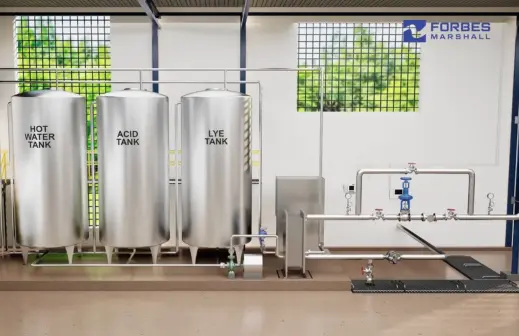Optimising Steam and Condensate Systems for CIP Efficiency in Food & Beverage Plants

In a typical food and beverage plant, saturated steam is utilised in various process applications as a primary source of energy for heat transfer. Most of these applications require heating upto a predefined temperature that is less than 90°C.
What is a CIP (Clean-in-Place) System
The Clean-in-Place or CIP system is used for cleaning the equipment without removing / dismantling them from their existing set-up. There can be multiple CIP systems in an F&B plant depending on its capacity and application. Plants have a centralised CIP system for all equipment in a plant with equipment specific dedicated CIP systems.
A CIP system includes tanks of hot water, caustic and acid , a plate type heat exchanger and a centrifugal pump. Each tank in the system needs to be maintained at a specific temperature. For conducting CIP on any equipment, first the temperature in the tanks is achieved to the set temperature. Then hot water is circulated in the equipment followed by caustic and hot water again. This entire cycle is completed in 15 minutes.
Important parameters in a CIP system
CIP of equipment can be carried out once in a day or once in a week depending on the usage of the equipment. To get the CIP system ready for the process, the temperature of water in the tanks needs to be increased from ambient to set temperatures (~80 deg. C) in a short span of 15-20 minutes. With a correctly designed steam and condensate network, the set temperature can be achieved in the required time without any temperature overshoot and without any manual intervention.
In case there is a temperature overshoot in relation to the set temperature, or if the time taken for achieving the set temperatures during start-up is high, then the steam flow regulation and condensate evacuation system needs to be reviewed.
Optimum Steam and Condensate Network
The optimum steam network starts with correct steam pressure selection. For the CIP system, process temperature of around 80 deg. C is needed. For achieving this temperature, low steam pressure of 2 bar g is recommended. Low pressure steam has higher latent heat content and it reduces the steam consumption for the equipment.
Control of steam temperature for the process could be by traditional manual methods or automated with on/off or PID based control. In on/off type control, temperature overshoot resulting in excess steam consumption, is commonly observed. A PID type temperature control system helps achieve precise temperature control.

An ideal Clean-in-Place (CIP) System Installation
A correctly selected and sized process trap impacts energy consumption, process efficiency, productivity, product quality and safety. The efficient removal of condensate from any process equipment requires positive differential pressure across the steam trap throughout the complete batch time of the process.
When this condition of positive differential pressure is not met, conventional process traps are unable to discharge the condensate and the system undergoes a phenomenon known as ‘stall’. And the process temperatures are not achieved when stall happens. A steam operated pumping trap ensures efficient removal of condensate during stall conditions and achieving of process temperatures without manual intervention.
Understanding Stall
The inability to evacuate condensate effectively from heat exchanging equipment is known as ‘stall’. This occurs when the pressure in the heat exchanger is equal to, or less than, the total backpressure acting on the outlet of the steam trap installed on the heat exchanger and the differential pressure across the steam trap becomes negative.
Visit this article to understand why stall occurs, its adverse effects and how it can be eliminated.




